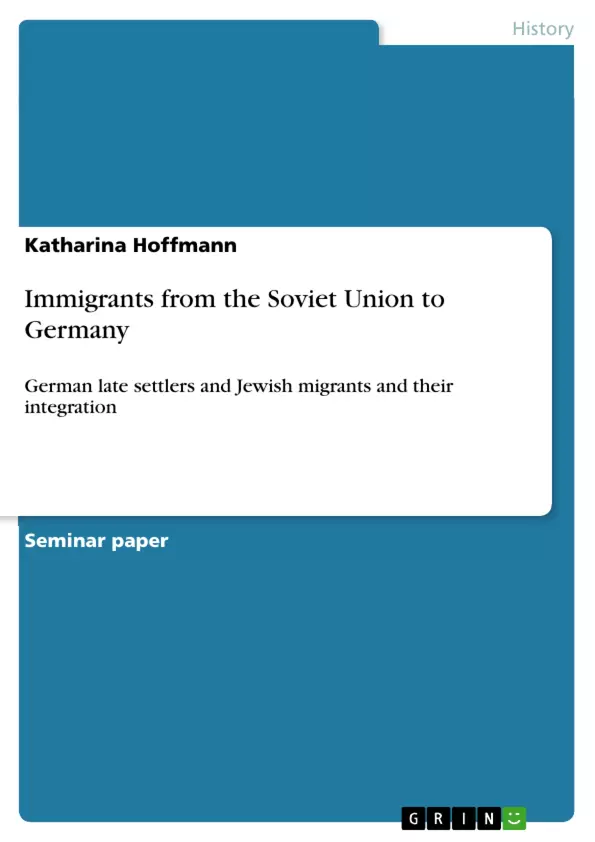The fall of the Berlin wall and the reunification soon after was a significant event in the German history and the history of the 20th century in general. But due to the Cold War and the separation of the world into East and West after the end of World War II, there were still brownfields to work on that were left behind the iron curtain.
One of these brownfields was the drawing of new German borders that came along with the formation of the Federal Republic of Germany (FRG) and the German Democratic Republic (GDR), both in 1949. Parts of the former German empire were cut off. A large amount of German citizens fled then to the west, others did not and most of them had to stay in Poland or elsewhere further east until 1989. Even more than 50 years after the end of World War II they were still considered as Germans and had therefore the right to live in the mother country. The fact, that they might have been “sovietized” in the meantime did not matter.
Another group that came along with these German late settlers was the Soviet Jews. Jews from the Soviet Union were invited to come to East Germany in 1990 shortly before the German reunification and the Federal Republic then held onto this invitation in order to let discriminated and persecuted Jews as refugees into Germany.
In the following paper I would like to regard the integration process of these two groups. Due to the fact that their motives to leave home and their situation in the Soviet Union was similar to each other I will regard this group mainly as one and will then focuse on the situation that awaited them in the new Germany. I will work on legal aspects and their public reception aiming to study on the question whether their particular privileged status concerning legal acknowledgement and support had also a particular influence on their assimilation in the German society and their identity.
Concerning their identity, the Spätaussiedler and the Soviet Jews are in a different situation then other immigrants in Germany or Europe. Their ethnical identity was their legal reason to migrate, the Spätaussiedler for the fact that they were ethnic Germans and were supposed to be brought ‘home’ and the Soviet Jews due to their discrimination in the SU. For that matter, it would be interesting to see in what way the Jewish congregation and the programs by the German government furthered their integration process.
Inhaltsverzeichnis (Table of Contents)
- Introduction
- Bulk
- Studied group of immigrants: German late settlers and Soviet Jews
- Origin
- Numbers and statistics
- The situation – reasons to leave the Soviet Union, reasons to go to Germany
- Legal situation
- Concerning the immigration
- Concerning the integration
- Integration
- Language skills
- Education and work
- Housing, criminality and other aspects
- In particular: integration into the Jewish congregation
- The public perception
- Studied group of immigrants: German late settlers and Soviet Jews
- Conclusion
Zielsetzung und Themenschwerpunkte (Objectives and Key Themes)
This paper aims to study the integration process of German late settlers and Soviet Jews who migrated to Germany after the fall of the Berlin Wall and the reunification of Germany. By examining their legal status, public perception, and integration experiences, the study seeks to understand whether their privileged status concerning legal acknowledgement and support had a specific influence on their assimilation into German society and their identity.
- The integration process of German late settlers and Soviet Jews in Germany
- The impact of legal status and public perception on assimilation and identity formation
- The role of the Jewish congregation and government programs in integration
- The convergent approach of viewing these two groups as one due to their similar motives and experiences
- The influence of public reception on immigrant self-esteem and integration
Zusammenfassung der Kapitel (Chapter Summaries)
- Introduction: This chapter sets the historical context of the study, highlighting the significance of the fall of the Berlin Wall and the reunification of Germany. It introduces the two groups of immigrants, German late settlers and Soviet Jews, and outlines their shared motives for leaving the Soviet Union. The chapter also discusses the convergent approach used in the study, focusing on the legal aspects and public reception of these immigrants.
- Bulk: This chapter delves into the characteristics of the studied group of immigrants, including their origin, numbers, and statistics. It explores the reasons for their emigration from the Soviet Union and their situation upon arriving in Germany. The chapter also examines the legal situation concerning immigration and integration, highlighting the legal framework surrounding their arrival and their particular privileged status.
- Integration: This chapter examines the integration process of the immigrants, focusing on their language skills, education and work opportunities, housing conditions, and involvement in criminal activities. It also specifically explores their integration into the Jewish congregation and the impact of government programs on their adaptation.
- The public perception: This chapter delves into the public perception of the immigrants in Germany, analyzing their reception by the German society and the influence of this perception on their self-esteem and integration. It also discusses the impact of the perceived similarities between German late settlers and Soviet Jews on their assimilation.
Schlüsselwörter (Keywords)
The main keywords and focus topics of this paper include: German late settlers, Soviet Jews, immigration, integration, assimilation, legal status, public perception, identity formation, Jewish congregation, government programs, convergent approach, and public reception.
- Citation du texte
- Katharina Hoffmann (Auteur), 2010, Immigrants from the Soviet Union to Germany, Munich, GRIN Verlag, https://www.grin.com/document/161224



